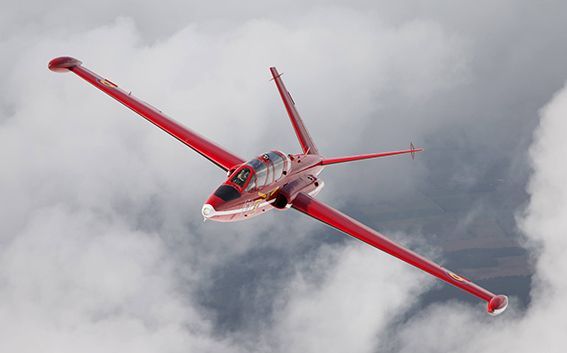
Fouga CM.170 Magister
The Fouga CM.170 Magister is a French two-seater trainer, which was developed in the fifties of the last century.
Development began in 1948, with the initial design falling short on propulsion. It was therefore modified and equipped with Turbomeca engines.
The first flight took place on July 23, 1952 and the first orders were placed on January 13, 1954.
A total of 929 aircraft were built, which were used in various air forces. A number of aircraft were built under license in Germany, Finland and Israel.
Although originally developed as a training aircraft, it was also used by some air forces as an attack aircraft. For example, Fougas were used in the Six-Day War, the Salvadoran Civil War and the Congo Crisis.
The Belgian Air Force operated 50 Fouga CM.170 Magisters. Some of them used by the renowned Belgian stunt team the “Red Devils”.
A small number of these aircraft remained in active service until 2007 as officer training aircraft. As a result, the Belgian Air Force was the last active user of Fouga Magisters.
The Return of a Fouga.
In the 1970s, Fouga MT05 regularly participated in the internationally acclaimed Red Devils stunt team.
After the dissolution of the team, it was shipped to Israel along with 10 others.
It was intended that they would be deployed there as training aircraft with the Israeli Air Force.
However, the aircraft were never made operational but were stored in the desert. In the early 1980s they were then resold and became available for the civilian market.
Jim Goodwin, an American admirer, bought the plane and made it flyable again. He flew it for decades, but eventually wanted to part with it for personal reasons.
When I heard about this from Tine of the Fouga Association, I contacted Jim and learned that he was flying it in Middlebury Vermont at a small airfield near the Canadian border. He asked who I was, why I might want to take over or purchase such an aircraft and when he heard that we have a flying museum in Antwerp, he was compliant because he wanted to send the aircraft, an ex-Belgian Red Devil, back to the homeland. However, I had to take it "as is" ie disassemble, load and ship. I messaged Jim that I agreed to bring the MT05 to our museum. We were then December 2014 and winter was in full swing in Vermont. Jim advised me to contact Jack Downey for disassembly and loading into a container and so it happened. The shipment was sponsored by MSC (Mediterranean Shipping Company). Apart from the weather problems, because it snowed almost daily in Middlebury, a new obstacle emerged: the export permit. According to the shipping company's forwarding agent, ex-military jets must have an export permit and this could take weeks!
In the meantime I had already consulted the Bureau of Industry and Commerce several times and after much insistence and explanation and the assurance that the Fouga was not a fighter plane but a trainer, it fell under different regulations and the export permit was no longer necessary. More than eight weeks had passed by then, but luckily the container could be shipped with the next shipment. We were already talking March 2015.
At the beginning of April, the MSC container ship docked in the port of Antwerp and after the necessary customs formalities, the truck with the MT05 arrived at the airport.
During the following months, the Fouga was made flyable again.
Because the aircraft had not flown for three years, everything was meticulously checked, all flexible pipes were renewed, static tests were carried out, engines borescopes, etc., all this according to the technical manual of the Air Force.
The first take-off and taxi tests were satisfactory and the test flight went according to plan. Pending the entry into force of the Royal Decree for historic jet aircraft, we fly with temporary exemptions.
We have been able to participate several times in the BAF days of Florennes and Sanicole. A successful formation and demo is regularly performed, together with the 4 Marchetti's of the Red Devils.
We hope that our Fouga will be seen regularly in the Belgian airspace for a long time to come, “Back home" where it belongs.
Stampe en Vertongen Museum vzw
Antwerp International Airport
Bus 3
B-2100 Antwerp-Deurne
Belgium
O.N. BE0447.236.613
RPR Antwerp
email: stampe@skynet.be
www.stampe.be
Opening hours individual visits
- Mon - Fri
- Closed
- Sat - Sun
- -
Closed on Easter Sunday and during August, December and January
Useful links
All rights reserved | Stampe en Vertongen Museum vzw






